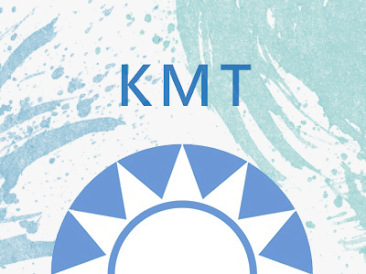 江主席:向保衛國家、建設國家的榮民致敬!
江主席:向保衛國家、建設國家的榮民致敬!
新 聞 稿 中國國民黨文化傳播委員會 109.10.30 江主席:向保衛國家、建設國家的榮民致敬! 中國國民黨主席江啟臣今(30)日晚間出席黃復興黨部舉辦的「復興初衷、榮耀心中」榮民之夜聯歡晚會時指出,明天是榮民節,也是蔣公誕辰紀念日,今晚的活動象徵國民黨跟榮民榮眷關係...
 江主席:向保衛國家、建設國家的榮民致敬!
江主席:向保衛國家、建設國家的榮民致敬!
新 聞 稿 中國國民黨文化傳播委員會 109.10.30 江主席:向保衛國家、建設國家的榮民致敬! 中國國民黨主席江啟臣今(30)日晚間出席黃復興黨部舉辦的「復興初衷、榮耀心中」榮民之夜聯歡晚會時指出,明天是榮民節,也是蔣公誕辰紀念日,今晚的活動象徵國民黨跟榮民榮眷關係...
 國民黨:民進黨掩飾老舊戰機問題,置飛行員安全於何地?
國民黨:民進黨掩飾老舊戰機問題,置飛行員安全於何地?
新 聞 稿 中國國民黨文化傳播委員會 109.10.30 國民黨:民進黨掩飾老舊戰機問題,置飛行員安全於何地? 針對民進黨指稱空軍F-5E戰機墜落台東外海的意外不應歸責於「國軍飛機老舊,新式高教機延遲交機」的問題,中國國民黨今...
 江主席「人脈を繋ぎ、台湾海峡の平和のために努力しよう」と華僑に望む
江主席「人脈を繋ぎ、台湾海峡の平和のために努力しよう」と華僑に望む
江主席「人脈を繋ぎ、台湾海峡の平和のために努力しよう」と華僑に望む 中国国民党主席江啟臣は12日午前、第68回華僑節大会に出席した際に「華僑は救国の母であるばかりでなく、建国の母でもあります」と述べました。華僑と中華民国の間には非常に密接な絆があり、それは永遠に切れないものである...
 國民黨:民眾感受治安不佳 政府責無旁貸
國民黨:民眾感受治安不佳 政府責無旁貸
新 聞 稿 中國國民黨文化傳播委員會 109.10.30 國民黨:民眾感受治安不佳 政府責無旁貸 中國國民黨今(30)日指出,馬來西亞來台女大生於台南遭隨機擄人殺害,引發社會震驚,也嚴重影響台灣的國際形象,如今痛定思痛,警政單位、教育部應儘速釐清案情,對於兇嫌並非首...
 民主、進步「擋」!擋地方瘦肉精零檢出,擋得了民意反撲?
民主、進步「擋」!擋地方瘦肉精零檢出,擋得了民意反撲?
新 聞 稿 中國國民黨文化傳播委員會 109.10.29 民主、進步「擋」!擋地方瘦肉精零檢出,擋得了民意反撲? 中國國民黨今(29)日召開「民主、進步『擋』!擋地方瘦肉精零檢出,擋得了民意反撲?」記者會,文傳會主委王育敏、副...
 國民黨強調,對於黨產捐作公益之立場與決心從未改變
國民黨強調,對於黨產捐作公益之立場與決心從未改變
新 聞 稿 中國國民黨文化傳播委員會 109.10.28 國民黨強調,對於黨產捐作公益之立場與決心從未改變 針對不當黨產處理委員會今(28)日在台北松山文創園區舉辦「不當黨產公民研討會」開幕活動時,國安會秘書長顧立雄致詞內容有...
 江主席:希望政府增設春節兩岸班機航點便利國人
江主席:希望政府增設春節兩岸班機航點便利國人
新 聞 稿 中國國民黨文化傳播委員會 109.10.28 江主席:希望政府增設春節兩岸班機航點便利國人 中國國民黨今(28)日中常會邀請海峽兩岸經貿文化交流協會會長高孔廉進行專題演講,針對兩岸關係惡化、兩岸交流重要性、兩岸和平等面向進行評析,主席於專題演講後進行幾點裁示...
 食安第一 江主席:只有是非 沒有藍綠
食安第一 江主席:只有是非 沒有藍綠
新 聞 稿 中國國民黨文化傳播委員會 109.10.28 食安第一 江主席:只有是非 沒有藍綠 距蔡英文總統突襲式宣布開放含瘦肉精豬肉及30月齡以上美牛進口已經兩個月,中國國民黨主席江啟臣今(28)日於中常會發表談話指出,兩個月前,蔡英文總統突襲式的宣布,不但缺乏配...
 【中/英】國民黨:引用網路圖片突顯蔡政府打壓台灣言論自由現狀 KMT: Image Post Has Evinced Current Situation of Tsai Administration Suppressing Taiwan’s Freedom of Speech
【中/英】國民黨:引用網路圖片突顯蔡政府打壓台灣言論自由現狀 KMT: Image Post Has Evinced Current Situation of Tsai Administration Suppressing Taiwan’s Freedom of Speech
新 聞 稿 中國國民黨文化傳播委員會 109.10.28 國民黨:引用網路圖片突顯蔡政府打壓台灣言論自由現狀 中國國民黨今(28)日指出,國民黨官方推特帳號上所轉載之網路圖片,目的是突顯蔡英文政府獨裁極權、打壓台灣言論自由的現在進行式,提醒全體國人及國外朋友,在民進黨執政下,台灣...
 台湾光復の四大意義を列挙 江主席「歴史を省み、和解と共生」
台湾光復の四大意義を列挙 江主席「歴史を省み、和解と共生」
台湾光復の四大意義を列挙 江主席「歴史を省み、和解と共生」 江啟臣中国国民党主席兼国家政策研究基金会会長は、本日二十二日午前から「台湾光復七十五周年研究会-『中華民国在台湾』の足跡」(臺灣光復七十五週年研討會-中華民國在臺灣的足跡)に出席しました。国家政策研究基金会が趙守博元台...
 台灣光復75週年音樂會 江主席:光復歷史意義不能遺忘
台灣光復75週年音樂會 江主席:光復歷史意義不能遺忘
新 聞 稿 中國國民黨文化傳播委員會 109.10.25 台灣光復75週年音樂會 江主席:光復歷史意義不能遺忘 中國國民黨主席江啟臣今(25)日下午出席台灣光復75週年紀念音樂會。江主席致詞表示,在政府淡忘台灣光復的此時,對岸又刻意放大舉辦台灣光復節,國民黨選...
 江主席:文攻武嚇只會讓兩岸民心越來越遠
江主席:文攻武嚇只會讓兩岸民心越來越遠
新 聞 稿 中國國民黨文化傳播委員會 109.10.23 江主席:文攻武嚇只會讓兩岸民心越來越遠 中國國民黨主席江啟臣今(23)日下午出席「慶祝抗戰勝利暨臺灣光復75週年與僑胞有約」茶會時指出,臺灣光復是世界華僑與海峽兩岸炎黄子孫共同奮鬥的光榮成就,兩岸彼此禍福相依、休...
 【中/ENG】列舉台灣光復四項重大意義 江主席:重省歷史、和解共生 Four Profound Meanings of Taiwan’s Retrocession Chairman Chiang: We Must Reflect on History and Seek True Reconciliation
【中/ENG】列舉台灣光復四項重大意義 江主席:重省歷史、和解共生 Four Profound Meanings of Taiwan’s Retrocession Chairman Chiang: We Must Reflect on History and Seek True Reconciliation
新 聞 稿 中國國民黨文化傳播委員會 109.10.22 列舉台灣光復四項重大意義 江主席:重省歷史、和解共生 中國國民黨主席暨國家政策研究基金會董事長江啟臣今(22)日上午出席「臺灣光復七十五週年研討會-中華民國在台灣的足跡」。主席表示,國政基金會邀請了幾位長期關注台...
 江主席:民進黨忽略台灣光復的史實,讓中共搶奪歷史詮釋權
江主席:民進黨忽略台灣光復的史實,讓中共搶奪歷史詮釋權
新 聞 稿 中國國民黨文化傳播委員會 109.10.21 江主席:民進黨忽略台灣光復的史實,讓中共搶奪歷史詮釋權 十月二十五日台灣光復節將屆,中國國民黨主席江啟臣今(21)日於中常會發表談話時指出,中國國民黨領導下的中華民國,在抗戰勝利後...
 ROC KMT臺灣光復75週年系列紀念活動
ROC KMT臺灣光復75週年系列紀念活動
新 聞 稿 中國國民黨文化傳播委員會 109.10.21 ROC KMT臺灣光復75週年系列紀念活動 中國國民黨今(21)日召開「ROC KMT臺灣光復75週年」紀念活動記者會,由文傳會主委王育敏、副主委鄭照新、國家政策研究基金會研究員盧宸緯共同公布系列活動規劃。國民黨...
 中国大陸大使館職員が我が国の外交官を殴り、中国国民党は中国大陸側にけん責、謝罪を求める
中国大陸大使館職員が我が国の外交官を殴り、中国国民党は中国大陸側にけん責、謝罪を求める
中国大陸大使館職員が我が国の外交官を殴り、中国国民党は中国大陸側にけん責、謝罪を求める メディアの報道によると、我が国の駐フィジー台北商務弁事処が国慶祝賀レセプションを開催した際、二人の駐フィジー中国大陸大使館職員が会場に乱入し、我が国の外交官を殴打しました。それに対し、中国国...
 流感疫苗亂象引發民怨高漲 蘇貞昌道歉了事?
流感疫苗亂象引發民怨高漲 蘇貞昌道歉了事?
新 聞 稿 中國國民黨文化傳播委員會 109.10.20 流感疫苗亂象引發民怨高漲 蘇貞昌道歉了事? 針對全台流感疫苗施打亂象,中國國民黨今(20)日召開記者會,質疑中央政府決策失當,未能因應局勢提前部署,導致基層公務員疲於奔命,全台民眾恐慌打不到疫苗。國民黨強調,錯...
 江主席「台湾光復は中華民国と台湾の重要な歴史的繋がり」
江主席「台湾光復は中華民国と台湾の重要な歴史的繋がり」
江主席「台湾光復は中華民国と台湾の重要な歴史的繋がり」 中国国民党江 啟 臣 主席は本日7日の中央常務委員会にて、中央常務委員会の開催を前に立法院本会期の党団幹部(会派幹部に相当)に免状を授与し、正式に任命したことを冒頭で発表しました。党団幹部とすべての同党立法委員た...
 【中/ENG】陸外交人員毆打我駐外人員,國民黨表達譴責,要求道歉 KMT Condemns Violence and Demands Apology from Mainland China over Gatecrashers Incident in Fiji
【中/ENG】陸外交人員毆打我駐外人員,國民黨表達譴責,要求道歉 KMT Condemns Violence and Demands Apology from Mainland China over Gatecrashers Incident in Fiji
新 聞 稿 中國國民黨文化傳播委員會 109.10.19 陸外交人員毆打我駐外人員,國民黨表達譴責,要求道歉 媒體報導我駐斐濟代表處舉行國慶活動時,兩名中國大陸駐斐濟外交人員竟闖入並動手打人,對此,中國國民黨今(19)日表達嚴厲譴責,要求中國大陸應公開道歉並嚴...
 中選會決議 國民黨:濫用行政權阻民意
中選會決議 國民黨:濫用行政權阻民意
新 聞 稿 中國國民黨文化傳播委員會 109.10.16 中選會決議 國民黨:濫用行政權阻民意 針對中選會今(16)日決議「公投併大選公投」、「反萊豬進口公投」二項提案均須先辦聽證會。領銜提出兩項公投案的中國國民黨質疑,中選會難道認為人民不希望擁有公投的權力嗎?多數...
 總統府密件漏天機,中天新聞台審照依劇本演?
總統府密件漏天機,中天新聞台審照依劇本演?
新 聞 稿 中國國民黨文化傳播委員會 109.10.15 總統府密件漏天機,中天新聞台審照依劇本演? 中國國民黨今(15)日召開「總統府密件漏天機,中天新聞台審照依劇本演?」記者會,文傳會主委王育敏、副主委王鴻薇、戴錫欽、鄭照新出席,質疑國...
 【中/ENG】民進黨傲慢粗暴 江主席:凸顯在野黨與媒體制衡重要性 The Arrogance and Insolence of the DPP Clearly Reveals the Importance of Checks and Balances by the Opposition Party & Media
【中/ENG】民進黨傲慢粗暴 江主席:凸顯在野黨與媒體制衡重要性 The Arrogance and Insolence of the DPP Clearly Reveals the Importance of Checks and Balances by the Opposition Party & Media
新 聞 稿 中國國民黨文化傳播委員會 109.10.14 民進黨傲慢粗暴 江主席:凸顯在野黨與媒體制衡重要性 中國國民黨主席江啟臣今(14)日於中常會發表談會先後指出幾點議題,南鐵地下化拆遷工程遭強勢進行,禮納里部落永久屋拆除問題,引發陳情自焚! 306元的政治獻金...
 校園食安,國民黨嚴格把關;民進黨消極放任!
校園食安,國民黨嚴格把關;民進黨消極放任!
新 聞 稿 中國國民黨文化傳播委員會 109.10.14 校園食安,國民黨嚴格把關;民進黨消極放任! 中國國民黨今(14)日召開「校園食安,國民黨嚴格把關;民進黨消極放任!」記者會,文傳會主委王育敏、副主委鍾沛君、發言人江怡臻出席,質疑...